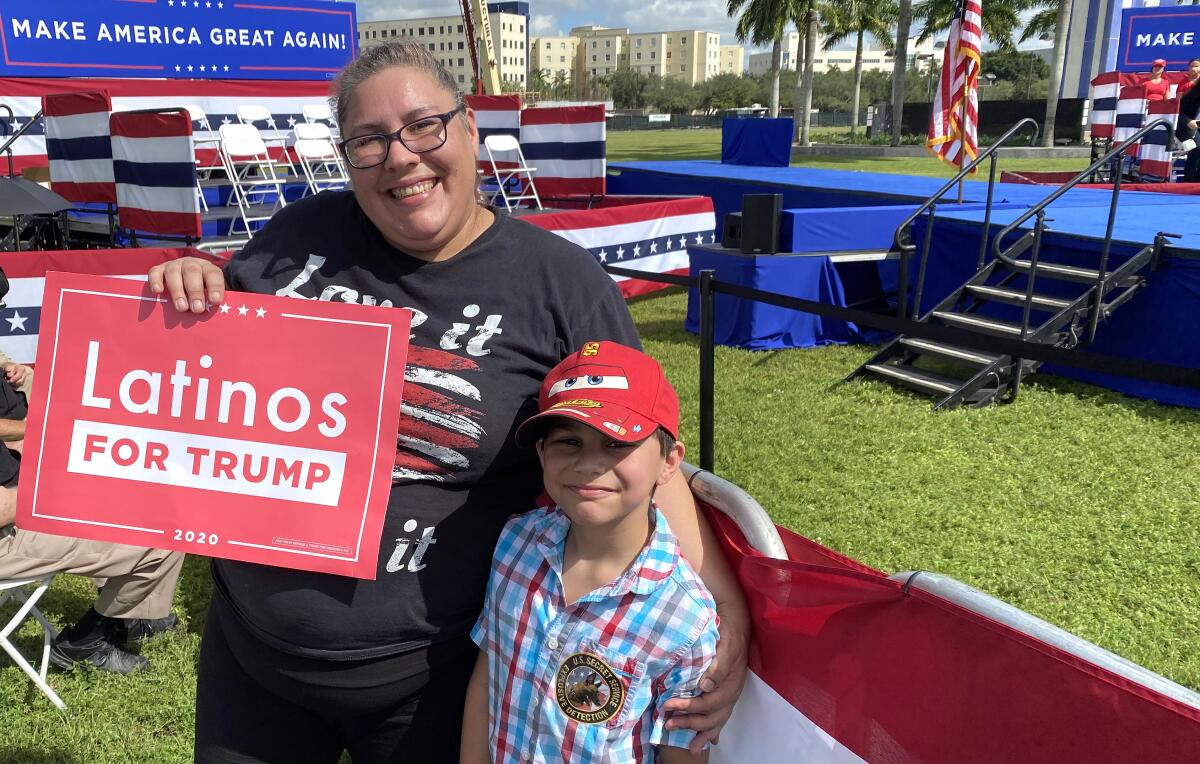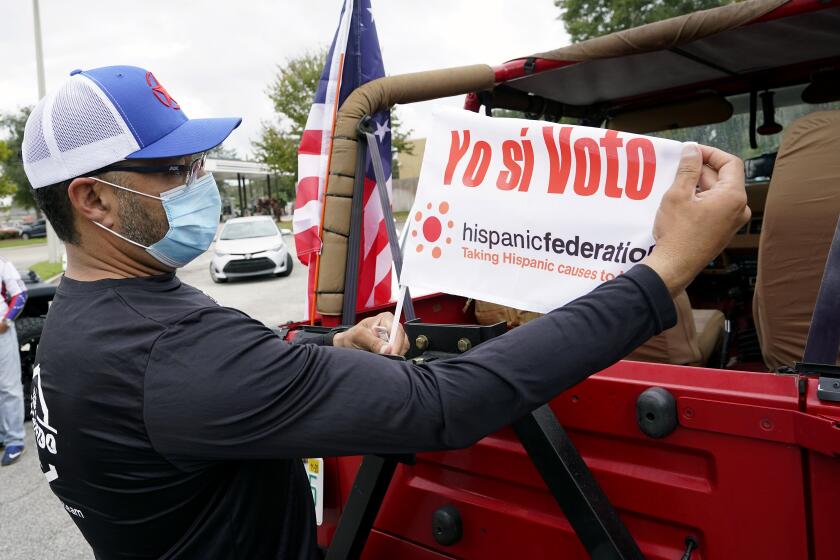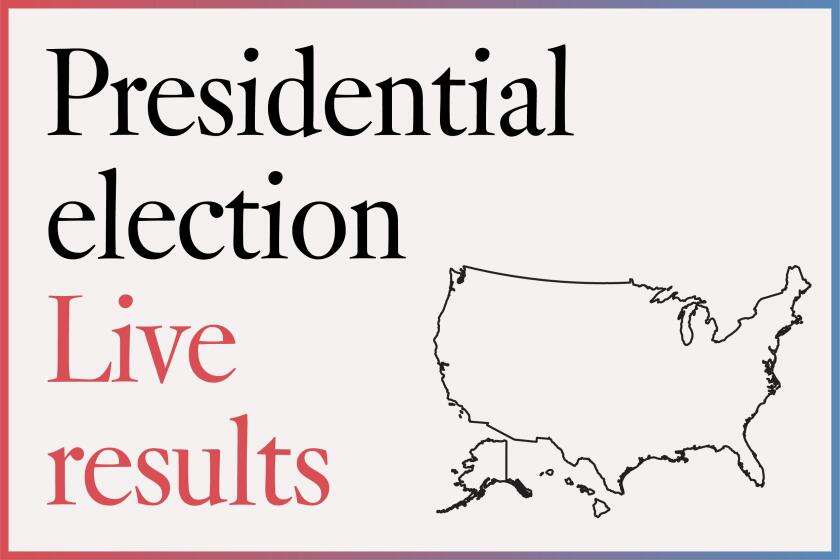Opinion: There is no ‘Latino voting bloc.’ Get used to it

- Share via
In the days since the polls closed, as the vote tallies in Georgia and Nevada trickled in with agonizing slowness, liberals and commentators wrung their hands over the huge number of voters — 69.5 million and counting — who backed President Trump for reelection and, specifically, all those Latinos turning out for him.
Not only did a sizable chunk of voters who identify as Latino support Trump, but it seems from exit polling they did so in larger numbers than in 2016.
What the hell happened? some wondered on social media and in cable news discussions.
Don’t Latinos know that this president spent four years denigrating immigrants, breaking up migrant families at the border and coddling white supremacists who, as a rule, don’t care much for people from non-European countries? OK, maybe the Cubans in Florida get a pass. They have always skewed more conservative. But Mexican Americans in south Texas or Central Americans anywhere — don’t they know better? Were they taken in by Trump’s absurd warning that Joe Biden would turn the U.S. into a socialist hellhole? Or did Democrats — once again — take Latino voters for granted?
I could almost feel the eyes of every Latino journalist rolling. Really, we have to go through this again, explaining that Latinos are a racially, culturally, socioeconomically diverse group of people with a wide range of hopes and dreams and political leanings and not a uniform voting bloc?
Lots of Latinos voted for Trump, and Democrats need to get over that already.
For one thing, this year’s Latino turnout was not anomalous. There’s been a similar partisan split in presidential elections going back at least to the 1980s, according to the Pew Research Center. Bob Dole did the poorest of recent Republican presidential candidates with this demographic, earning just 21% in 1996 when he unsuccessfully challenged President Clinton. President George W. Bush, by contrast, did quite well, getting reelected in 2004 with about 40% of the Latino vote.
In this context, the estimated 27% of Latino voters who chose Trump over former Vice President Joe Biden seems unremarkable. So why all fuss?
What changed this year, it seems, were the assumptions made by liberals that cruel Trump policies like border separation would upend historical patterns by pushing traditionally conservative Latinos away from the Republican Party and into the arms of the immigrant-friendly Democrats.
It’s a political cliche grounded in a frustratingly and repeatedly misunderstood reality.
Oops. That assumption isn’t just offensively reductive; it’s not a winning strategy.
Republicans, frankly, have done a better job of speaking to Latino voters as, well, just voters. Geraldo L. Cadava, an associate professor at Northwestern University and author of “The Hispanic Republican,” said the Trump administration relentlessly wooed Latino voters over the last four years and did it by appealing to pragmatic interests rather than emotions. “It’s almost like a split-screen image,” he described it to me, “where you have Trump maligning immigrants over Twitter but then talking to business owners and Latinos about expanding educational opportunities.” That resonated. Trump went further by presenting himself as the protector of religious freedom and small business, things that appeal to conservatives of every ethnicity.
“There are no shortcuts to organize Latinx voters,” Lorella Praeli, president of Community Change Action, said during a Zoom panel discussion Thursday on Latino turnout in Tuesday’s election. “You can’t overgeneralize our community. You need to understand that we are different in New Mexico, and we are different in Nevada and different in the state of Florida.”
And more difference abounds still as you drill down. Latinos in Arizona, for example, went heavily for Biden, putting him on the brink of flipping that fast-growing state.
There are racial and class differences, religious and gender differences, Generations matter too. In a new book, two academic researchers, Michael Jones-Correa of the University of Pennsylvania and James A. McCann from Purdue University, surveyed first-generation Latinos in the United States (that is, people born outside the country) several times over the course of the months before and after the 2016 election and found that more recent immigrants don’t have strong political party loyalties and that Latinos’ perception of Trump is shaped by the proximity of their immigrant experience. A third-generation Mexican American, for example, may not feel that Trump’s threats about curbing immigration have any application to her family and might be more interested in his policies that have affected her family’s finances.
The lesson here is that, if you want to figure out Latino voters, then you have to approach them as Americans who have a similar ethnic heritage but whose interests may be as varied as their backgrounds and the communities in which the reside. “We have to recognize Latinos as full and complex human beings,” Cadava said. “What’s wrong with that?”
Exactly.
More to Read
A cure for the common opinion
Get thought-provoking perspectives with our weekly newsletter.
You may occasionally receive promotional content from the Los Angeles Times.













